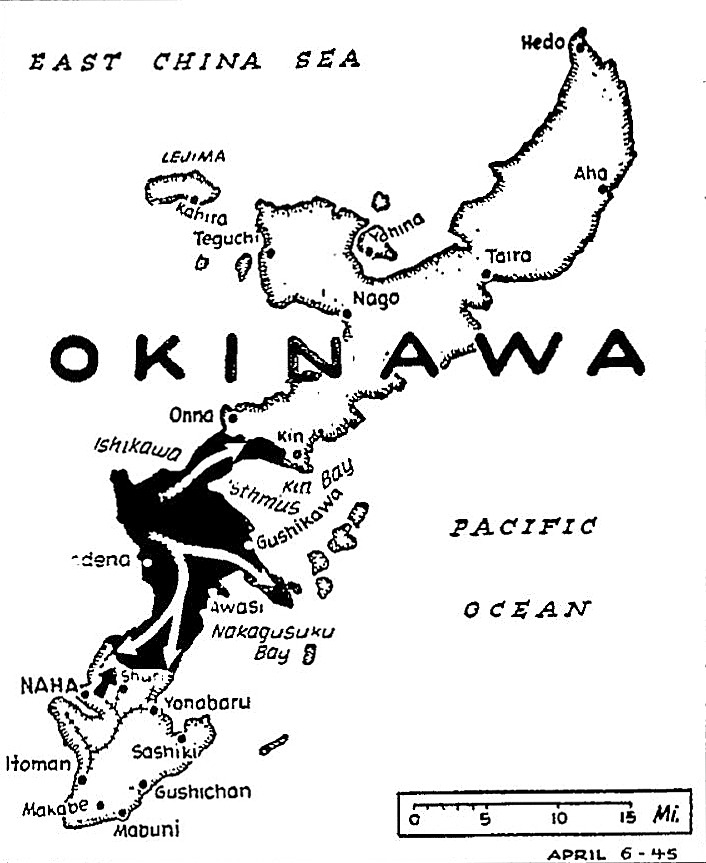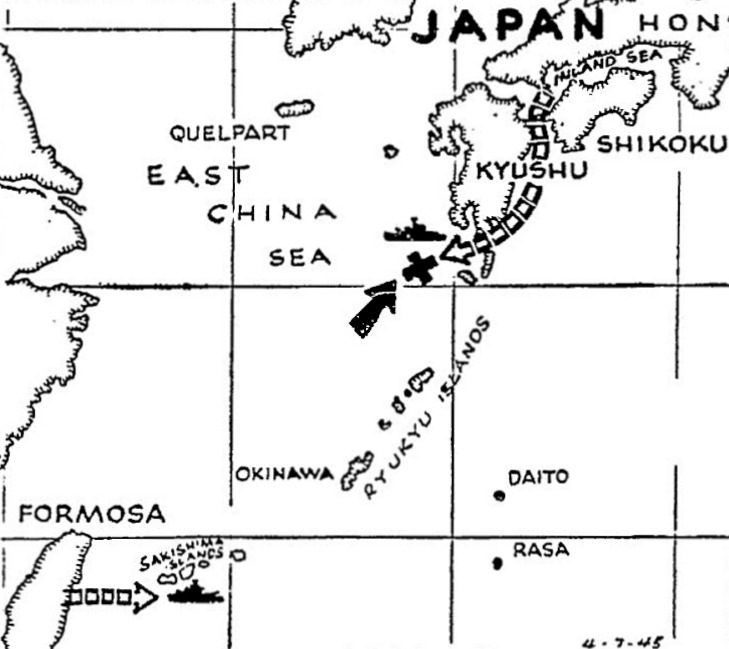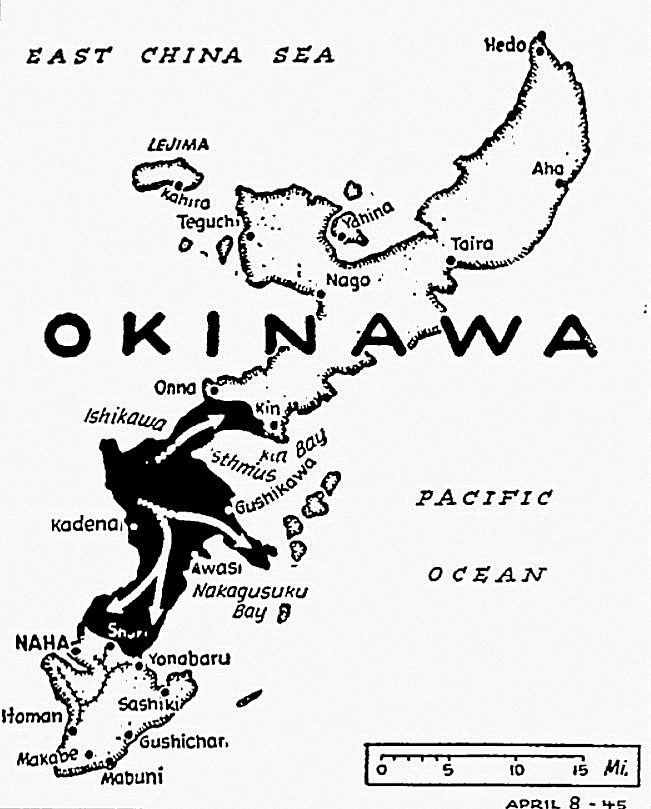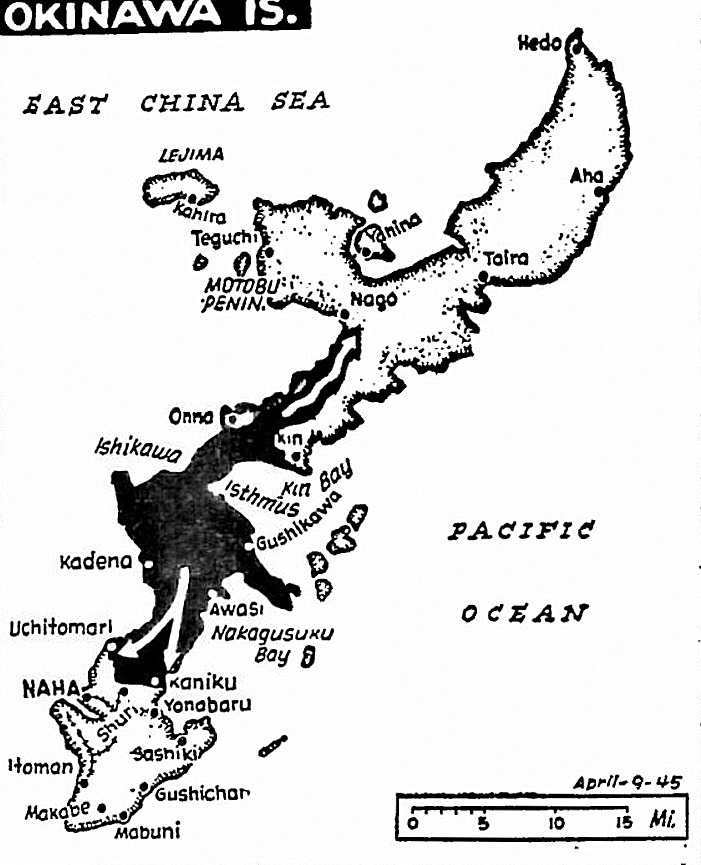The Pittsburgh Press (April 4, 1945)
Yanks drive for two more Jap airfields
Okinawa invaders push down coasts
GUAM (UP) – Tenth Army columns pushed down the east and west coasts of Okinawa today within striking distance of two more Jap airfields and only six miles or less from Naha, capital of the island.
Resistance was still negligible as the greatest invasion of the Pacific war went into its fourth day only 362 miles southwest of Japan. But the enemy garrison of 60,000 may make its first stand in the next few hours along a line across the narrow isthmus just north of the airfields.
A German DNB dispatch from Tokyo said U.S. troops made a new landing on Okinawa Tuesday south of the original beachhead.
A Jap communiqué claimed that six more U.S. transports, a battleship and four cruisers had been sunk in the invasion armada. An additional destroyer and an unidentified ship were listed as damaged.
Seize 7-mile stretch
The 7th Infantry Division seized nearly seven miles of the east coast in a drive along the Nakagusuku Bay naval anchorage yesterday to Kuba, four miles north of the uncompleted Yonabaru Airfield.
Another army division smashing down the west coast against moderate opposition reached Chiyunna, four miles north of Machinato Airfield and six miles north of Naha, a city of 65,000.
Two other airfields farther north were captured by the Americans on the first day of the invasion and were already in operation.
The Army forces were under orders to advance at all possible speed in an attempt to break through the narrow isthmus separating the south-central budge of the island from the southern bulge in which Naha is situated.
‘Keep driving ahead’
“Keep on driving ahead,” Maj. Gen. John R. Hodge, commander of the XXIV Army Corps, told his field commanders. “We can’t kill Japs standing still.”
At the northern end of the front, Maj. Gen. Roy S. Geiger’s III Marine Amphibious Corps also slashed across the island to the east coast in advances of up to 3½ miles.
The Marines reached the east coast, near the Katchin Peninsula, northern arm of Nakagusuku Bay, and sealed off that narrow jut of land. The thrust completed a second steel band across the southern third of the island.
The entire Jap garrison was believed concentrated in the southern bulge of Okinawa surrounding Naha for a fight to the death. A majority of the island’s 435,000 civilians probably moved to the more rugged northern two-thirds of the island.
Front dispatches said the main advance on Naha down the west coast was being slowed by the necessity of bridging deep ravines. The Japs blew up three bridges within a few miles and army engineers were throwing prefabricated Bailey bridges across the ravines under enemy fire.
Big guns of the 1,400-ship invasion armada joined some 1,500 carrier planes in supporting the ground forces with an around-the-clock bombardment of Naha and other strongpoints on Okinawa, as well as on other Jap islands in the Ryukyu chain.
Targets in the Sakishima Islands southwest of Okinawa were attacked by carrier planes yesterday.
The unloading of supplies across the beach of Okinawa continued “satisfactorily,” an American communiqué said. It reported that 11 counterattacking enemy planes were shot down over the island by anti-aircraft guns and carrier planes.
The communiqué also revealed that carrier planes destroyed or damaged 39 Jap ships and small craft and 41 enemy aircraft in the last two days of the pre-invasion bombardment of the Ryukyus Saturday and Sunday.
Summary of the bombardment showed:
SHIPPING:
- Sunk: Three motor torpedo boats, two small cargo ships, nine small craft.
- Probably sunk: One small cargo ship, four small craft.
- Damaged: One motor torpedo boat, four small cargo ships, one lugger, 14 small craft.
AIRCRAFT:
- Shot down: 17
- Destroyed on the ground: 5
- Damaged: 19
GROUND INSTALLATIONS:
Six submarine pens on Unten Bay, Okinawa, destroyed and another heavily damaged. A mill, barracks, radio stations, pillboxes, buildings, docks, gun positions and covered revetments destroyed or damaged on Okinawa. Other installations on Tokuno, Amami, Kikai and Minami Daito Islands hit heavily.



